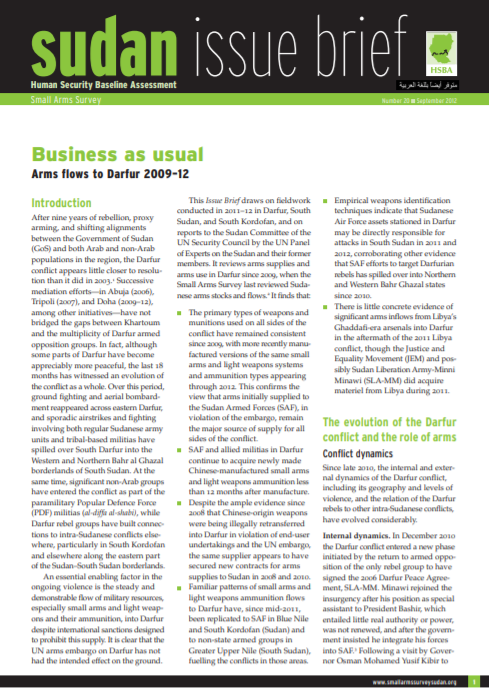
Business as Usual: Arms Flows to Darfur 2009-12 (HSBA Issue Brief 20)
After nine years of rebellion, proxy arming, and shifting alignments between the Government of Sudan (GoS) and both Arab and non-Arab populations in the region, the Darfur conflict appears little closer to resolution than it did in 2003. 1 Successive mediation efforts—in Abuja (2006), Tripoli (2007), and Doha (2009–12), among other initiatives—have not bridged the gaps between Khartoum and the multiplicity of Darfur armed opposition groups. In fact, although some parts of Darfur have become appreciably more peaceful, the last 18 months has witnessed an evolution of the conflict as a whole. Over this period, ground fighting and aerial bombardment reappeared across eastern Darfur, and sporadic airstrikes and fighting involving both regular Sudanese army units and tribal-based militias have spilled over South Darfur into the Western and Northern Bahr al Ghazal borderlands of South Sudan. At the same time, significant non-Arab groups have entered the conflict as part of the paramilitary Popular Defence Force (PDF) militias (al-diffa al-shabi), while Darfur rebel groups have built connections to intra-Sudanese conflicts elsewhere, particularly in South Kordofan and elsewhere along the eastern part of the Sudan–South Sudan borderlands.
An essential enabling factor in the ongoing violence is the steady and demonstrable flow of military resources, especially small arms and light weapons and their ammunition, into Darfur despite international sanctions designed to prohibit this supply. It is clear that the UN arms embargo on Darfur has not had the intended effect on the ground.
Business as Usual: Arms Flows to Darfur 2009-12 draws on fieldwork conducted in 2011–12 in Darfur, South Sudan, and South Kordofan, and on reports to the Sudan Committee of the UN Security Council by the UN Panel of Experts on the Sudan and their former members. It reviews arms supplies and arms use in Darfur since 2009, when the Small Arms Survey last reviewed Sudanese arms stocks and flows.
Also available in ARABIC.
Have your say about Small Arms Survey publications and products: take 5 minutes to fill out our questionnaire.